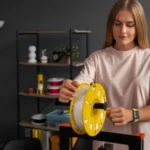Robot waiters are increasingly being adopted in restaurants around the world. These innovative tools are revolutionizing the way dining establishments operate, offering numerous benefits that enhance both the operational aspects and the customer experience. From boosting the speed of service to improving order accuracy, restaurant robot waiters contribute significantly to efficiency. This technology also promises financial savings by reducing labor costs. For diners, robot waiters add a futuristic touch, offering both engagement and personalization. This blog explores their impact and the potential trends shaping the future of dining.
Improving Operational Efficiency
Speeding Up Service and Reducing Wait Times
Robot waiters excel at enhancing dining service speed by efficiently delivering food and drinks to tables. Unlike human staff, they don’t get tired or require breaks, ensuring constant and prompt service. This leads to a significant reduction in wait times for customers, as meals are served more swiftly. Restaurants benefit from faster table turnovers, which can increase the number of customers served per day. The use of robots for repetitive tasks allows human staff to focus on more complex duties, further streamlining operations.
Enhancing Order Accuracy and Reducing Errors
Accuracy in order taking and delivery is crucial in the restaurant industry. Robot waiters use advanced sensors and software to ensure orders are delivered to the correct tables without errors. This technology minimizes the chances of miscommunication or human mistakes, leading to higher customer satisfaction. By reducing order errors, restaurants save on the costs associated with correcting mistakes and maintaining their reputation for reliable service. Enhanced accuracy also builds trust with customers, encouraging repeat visits and positive reviews.
Cost Reduction and Financial Benefits for Restaurants
Lower Labor Costs and Staffing Efficiency
Implementing robot waiters can lead to significant labor cost savings for restaurants. With robots handling routine tasks, restaurants can operate with a smaller staff, reducing wage expenses. This is particularly beneficial in regions with high minimum wage requirements. Robots don’t require benefits, vacation time, or overtime pay, which contributes to overall cost-efficiency. Additionally, robots offer consistency and reliability, reducing the challenges associated with staffing shortages and employee turnover.
Reducing Operational Overheads
Beyond labor cost savings, robots help reduce other operational expenses. Their precision in performing tasks minimizes waste, such as excess food or drink spills. Energy-efficient machinery and self-charging capabilities ensure robots work optimally without significant power costs. Maintenance for robots, while necessary, is less frequent and often less costly than human resource management. These financial benefits free up capital for investment in other areas of the business, such as enhancing the customer dining experience or improving kitchen equipment.
Enhancing the Customer Experience
Creating a Futuristic and Engaging Dining Experience
The presence of robot waiters captivates customers, offering a unique dining experience that few establishments can boast. This futuristic approach draws attention, encouraging more visits from curious patrons eager to see the technology in action. The novelty of robot waiters can turn a routine meal into a memorable event, providing restaurants with an edge in customer attraction and retention. This engagement not only boosts foot traffic but also generates buzz, potentially attracting media attention and social media shares.
Personalization and Customization for Customers
Robot waiters equipped with AI can cater to individual customer preferences by remembering orders and suggesting personalized menu items. This technology enhances the dining experience by making it more tailored and attentive to specific needs. Customization adds value for the customer, making them feel special and understood. Restaurants can thus build stronger relationships with their patrons, fostering loyalty and encouraging repeat business. Personalization, powered by robot waiters, ensures a dining experience that aligns closely with customer expectations.

The Competitive Advantage of Robot Waiters
Differentiating in a Crowded Market
In an industry where competition is fierce, standing out is essential. Robot waiters differentiate restaurants by providing a unique selling point that competitors may not offer. This innovative technology not only attracts new customers but also retains existing ones who appreciate the novelty and efficiency. By adopting robot waiters, restaurants position themselves as forward-thinking and technology-savvy, appealing to tech enthusiasts and modern diners.
Innovation as a Key to Future Success
The integration of robot waiters signifies a commitment to innovation, essential for long-term success in the restaurant industry. Embracing technology keeps establishments ahead of trends, preparing them for future advancements. Innovation fosters resilience in the face of industry challenges, such as labor shortages or rising operational costs. By investing in robotic solutions, restaurants demonstrate their adaptability and readiness for growth, ensuring they remain relevant and competitive in an ever-evolving market.
Conclusion
The adoption of robot waiters is reshaping the restaurant industry by improving operational efficiency, cutting costs, and enriching the customer experience-their ability to deliver rapid, accurate service benefits both the restaurant and its patrons. Financial advantages include reduced labor costs and minimized operational overheads. For customers, robot waiters usher in a futuristic and personalized dining experience, setting establishments apart from their competitors. As more restaurants adopt this technology, it becomes clear that innovation plays a crucial role in maintaining a competitive edge. The impact of robot waiters heralds a promising future for the restaurant industry, marked by enhanced efficiency and innovative customer service.










 /home/u448362301/domains/theexpotab.com/public_html/wp-content/themes/foxiz/templates/popup.php on line 167
/home/u448362301/domains/theexpotab.com/public_html/wp-content/themes/foxiz/templates/popup.php on line 167